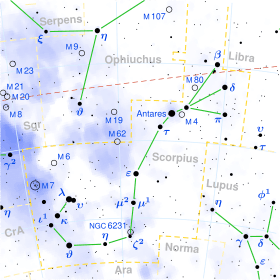G Scorpii
G Scorpii (abbreviated G Sco), also named Fuyue, is a giant star in the constellation of Scorpius. It has an apparent magnitude of +3.19. It is approximately 126 light-years from the Sun.
| Observation data Epoch J2000 Equinox J2000 | |
|---|---|
| Constellation | Scorpius |
| Right ascension | 17h 49m 51.48081s[1] |
| Declination | −37° 02′ 35.8975″[1] |
| Apparent magnitude (V) | 3.21[2] |
| Characteristics | |
| Spectral type | K2 III[3] |
| U−B color index | +1.19[2] |
| B−V color index | +1.17[2] |
| Astrometry | |
| Radial velocity (Rv) | +24.7[4] km/s |
| Proper motion (μ) | RA: 40.59[1] mas/yr Dec.: 27.24[1] mas/yr |
| Parallax (π) | 25.92 ± 0.15[1] mas |
| Distance | 125.8 ± 0.7 ly (38.6 ± 0.2 pc) |
| Absolute magnitude (MV) | +0.24[5] |
| Details[6] | |
| Mass | 1.2±0.2[6] M☉ |
| Radius | 20±1[6] R☉ |
| Luminosity | 93±4[6] L☉ |
| Surface gravity (log g) | 2.2[6] cgs |
| Temperature | 4,535±125[6] K |
| Metallicity [Fe/H] | −0.20[7] dex |
| Rotational velocity (v sin i) | <1.0[8] km/s |
| Other designations | |
| Database references | |
| SIMBAD | data |
Nomenclature

G Scorpii is the star's Bayer designation. It was formerly situated in the constellation of Telescopium where it was designated γ Telescopii, Latinised to Gamma Telescopii.[9] It was resited in Scorpius and redesignated G Scorpii by Gould.[10]
In 2016, the IAU organized a Working Group on Star Names (WGSN)[11] to catalog and standardize proper names for stars. The WGSN approved the name Fuyue for this star on 30 June 2017 and it is now so included in the List of IAU-approved Star Names.[12]
G Scorpii bore the traditional name Fuyue (simplified Chinese: 傅说; traditional Chinese: 傅說)in ancient China. Fu Yue was a former slave that became a high-ranking minister to Shang dynasty ruler, Wu Ding. G Scorpii is a member of the Tail mansion (尾宿, pinyin: Wěi Xiù), one of the twenty-eight mansions of the Chinese constellations.
Properties
G Scorpii is an orange K-type giant. The measured angular diameter is 3.94 ± 0.21 mas.[13] At the estimated distance of this system, this yields a physical size of about 16 times the radius of the Sun.[14] Calculations based on its physical properties give a diameter if about 20 R☉. With an effective surface temperature of 4,535 K, it has a bolometric luminosity of 93 L☉.[6]
Evolutionary models show that G Scorpii has probably left the red giant branch and is now fusing helium in its core. This makes it a red clump star, at the cool end of the horizontal branch.[6]
Just 5 arcminutes to the east is the globular cluster NGC 6441.[15] At magnitude 3.2, G Scorpii is around 40 times brighter than the entire globular cluster.
References
- van Leeuwen, F. (November 2007), "Validation of the new Hipparcos reduction", Astronomy and Astrophysics, 474 (2): 653–664, arXiv:0708.1752, Bibcode:2007A&A...474..653V, doi:10.1051/0004-6361:20078357.
- Johnson, H. L.; et al. (1966), "UBVRIJKL photometry of the bright stars", Communications of the Lunar and Planetary Laboratory, 4 (99): 99, Bibcode:1966CoLPL...4...99J.
- Gray, R. O.; et al. (July 2006), "Contributions to the Nearby Stars (NStars) Project: Spectroscopy of Stars Earlier than M0 within 40 pc-The Southern Sample", The Astronomical Journal, 132 (1): 161–170, arXiv:astro-ph/0603770, Bibcode:2006AJ....132..161G, doi:10.1086/504637.
- Wilson, Ralph Elmer (1953). General Catalogue of Stellar Radial Velocities. Washington: Carnegie Institution of Washington. Bibcode:1953GCRV..C......0W.
- Cardini, D. (January 2005), "Mg II chromospheric radiative loss rates in cool active and quiet stars", Astronomy and Astrophysics, 430: 303–311, arXiv:astro-ph/0409683, Bibcode:2005A&A...430..303C, doi:10.1051/0004-6361:20041440.
- Kallinger, T.; Beck, P. G.; Hekker, S.; Huber, D.; Kuschnig, R.; Rockenbauer, M.; Winter, P. M.; Weiss, W. W.; Handler, G.; Moffat, A. F. J.; Pigulski, A.; Popowicz, A.; Wade, G. A.; Zwintz, K. (2019), "Stellar masses from granulation and oscillations of 23 bright red giants observed by BRITE-Constellation", Astronomy and Astrophysics, 624: A35, arXiv:1902.07531, Bibcode:2019A&A...624A..35K, doi:10.1051/0004-6361/201834514.
- Charbonnel, C.; Lagarde, N.; Jasniewicz, G.; North, P. L.; Shetrone, M.; Krugler Hollek, J.; Smith, V. V.; Smiljanic, R.; Palacios, A.; Ottoni, G. (2020), "Lithium in red giant stars: Constraining non-standard mixing with large surveys in the Gaia era", Astronomy and Astrophysics, 633: A34, arXiv:1910.12732, Bibcode:2020A&A...633A..34C, doi:10.1051/0004-6361/201936360.
- De Medeiros, J. R.; Alves, S.; Udry, S.; Andersen, J.; Nordström, B.; Mayor, M. (2014), "A catalog of rotational and radial velocities for evolved stars. V. Southern stars", Astronomy and Astrophysics, 561: A126, arXiv:1312.3474, Bibcode:2014A&A...561A.126D, doi:10.1051/0004-6361/201220762.
- Ian Ridpath, "Telescopium", Star Tales, retrieved 2020-05-23.
- Wagman, Morton (2003), Lost Stars: Lost, Missing and Troublesome Stars from the Catalogues of Johannes Bayer, Nicholas Louis de Lacaille, John Flamsteed, and Sundry Others, Blacksburg, Virginia: The McDonald & Woodward Publishing Company, Bibcode:2003lslm.book.....W, ISBN 978-0-939923-78-6.
- IAU Working Group on Star Names (WGSN), retrieved 22 May 2016.
- Naming Stars, IAU.org, retrieved 16 December 2017.
- Richichi, A.; Percheron, I.; Khristoforova, M. (February 2005), "CHARM2: An updated Catalog of High Angular Resolution Measurements", Astronomy and Astrophysics, 431 (2): 773–777, Bibcode:2005A&A...431..773R, doi:10.1051/0004-6361:20042039
- Lang, Kenneth R. (2006), Astrophysical formulae, Astronomy and astrophysics library, 1 (3rd ed.), Birkhäuser, ISBN 3540296921.. The radius (R*) is given by:
- O'Meara, Stephen James (2013), Deep-Sky Companions: Southern Gems, Cambridge University Press, pp. 360–363, Bibcode:2013dcsg.book.....O, ISBN 978-1139851541.
